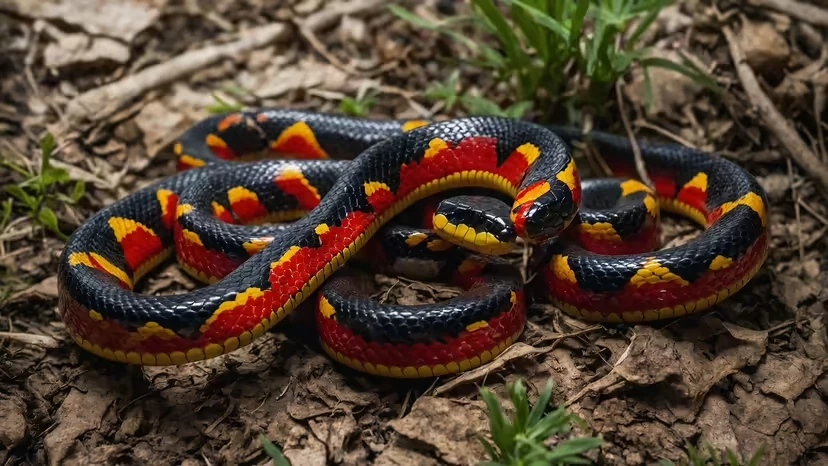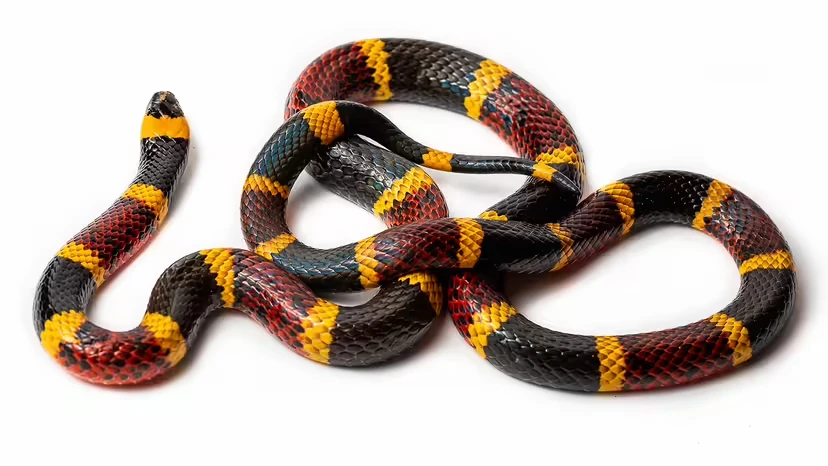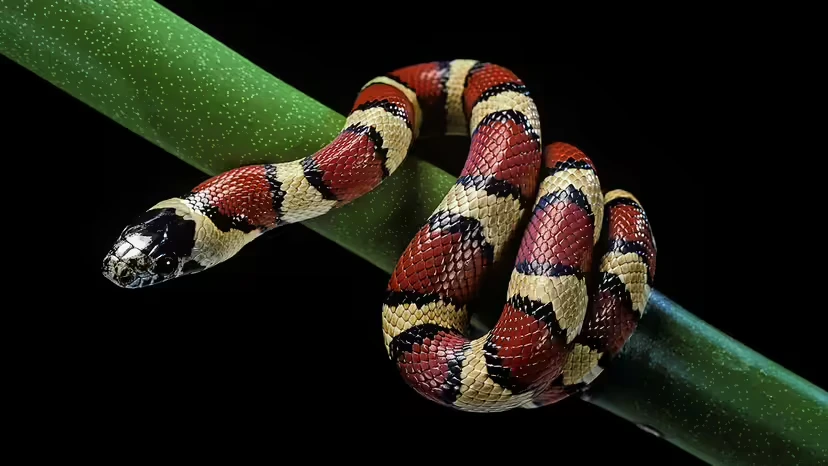Bottom line: Coral snakes (venomous) and scarlet kingsnakes (nonvenomous) can look confusingly similar at a glance. Careful band order, ring width, and a few body details separate them—and there are important exceptions you should know.

Quick ID: 10-second checklist
Coral snakes: appearance, range, behavior, and bites
Kingsnakes (incl. scarlet kingsnake & milk snake): appearance, range, behavior
The rhyme problem: when “red touch yellow” fails
Side-by-side comparison table
Look-alikes you’ll meet in North America
Safety: what to do if you encounter or are bitten
FAQ
Band order
Eastern/Tx coral snake (Micrurus): Red–Yellow–Black–Yellow–Red (red touches yellow). Bands typically complete rings around the body, including the tail.
Scarlet kingsnake / milk snake (Lampropeltis): Red–Black–Yellow (or white)–Black–Red (red touches black). Black bands usually separate red from yellow/white.
Black snout & face
Coral: Solid black snout extending onto the head.
Kingsnake: Snout often red/patchy, not a full black mask.
Band shape & width
Coral: Yellow bands narrow and crisp; ring pattern typically full and even around the body and tail.
Kingsnake: Black bands wider, yellow/white often paler, rings sometimes don’t fully encircle the belly.
If you’re not 100% sure, don’t handle the snake. Misidentification happens—especially with juveniles or muddy color forms.
Appearance
Glossy, smooth scales with high-contrast red–yellow–black triads.
Red touching yellow is the classic warning pattern in U.S. species (M. fulvius—eastern coral snake; M. tener—Texas coral snake).
Head: usually black snout; bands typically complete around body and tail.
Range & habitat (U.S.)
Southeast: Florida across Gulf states; sandy pinewoods, scrub, hammocks, edges, and leaf litter.
Texas: Texas coral snake overlaps piney woods to coastal prairie and brush.
Behavior & diet
Secretive, fossorial tendencies; most activity at dawn/dusk.
Feeds primarily on small snakes and lizards.
Venom & bites
Potent neurotoxin affecting the nervous system; symptoms can be delayed but serious: localized pain may be mild at first, followed by weakness, ptosis, slurred speech, respiratory compromise.
Human bites are rare, but medical care is urgent—treat as a life-threatening emergency.

Appearance
Scarlet kingsnake (L. elapsoides) / Eastern milk snake complex: red, black, and yellow/white bands; red touches black.
California kingsnake, Eastern kingsnake, etc.: patterns vary (bands, stripes, speckles), often brown/black with white/cream.
Range & habitat
Widespread across North America; forests, fields, rocky outcrops, farmlands, deserts. Adaptable, often near cover boards, logs, or edges.
Behavior & diet
Constrictors; eat rodents, lizards, birds, other snakes—including venomous species (partial venom resistance).
Frequently encountered around human edges; excellent climbers.
Bite risk
Nonvenomous. May musk or nip when handled; pose no venom threat.

The old rhyme “Red touch yellow, kill a fellow; red touch black, friend of Jack” is only broadly reliable for U.S. species and even then not perfect.
Outside the U.S. (Mexico, Central/South America) there are Micrurus species with atypical band orders or colors.
Some U.S. kingsnakes/milksnakes have faded yellows, dirty whites, or incomplete rings that can mislead.
Rule: If you’re not fully confident, do not handle—take a photo at safe distance for an expert.
| Feature | Coral snake (Micrurus) | Kingsnake / Scarlet kingsnake (Lampropeltis) |
|---|---|---|
| Venom | Venomous (neurotoxic) | Nonvenomous (constrictor) |
| Band contact (typical U.S.) | Red touches yellow | Red touches black |
| Ring completion | Bands often encircle body & tail | Rings may not fully encircle; belly often lighter |
| Head | Black snout/face mask common | Snout often red or patterned, not fully black |
| Scale sheen | Glossy, smooth | Glossy to satiny |
| Behavior | Secretive, reluctant to strike; powerful bite if restrained | Bold, adaptable; may vibrate tail, musk; will bite if grabbed |
| Diet | Small snakes, lizards | Rodents, lizards, birds, snakes (incl. venomous) |
| Range (U.S.) | Southeast & parts of TX | Across much of North America |

Scarlet kingsnake (L. elapsoides) vs. Eastern coral: the classic confusion pair. Confirm band contact and black snout.
Milk snakes (L. triangulum complex): some have red/black/light triads; again check red–black contact.
Juvenile rat snakes, hognose, or garter snakes: patterns can be deceptive in low light—use band order, ring completion, and snout color.
Encounter
Keep 2+ body lengths away; don’t try to move or kill the snake.
Take a clear photo at distance for identification if needed.
Let the snake leave on its own; supervise pets and children.
If bitten (suspected coral snake)
Call emergency services immediately.
Stay calm, minimize movement; splint/immobilize the limb at heart level.
Remove rings/watches before swelling.
Do NOT cut, suction, apply ice, or use a tourniquet.
Reach a hospital for monitoring and antivenom if indicated.
If bitten (kingsnake/nonvenomous)
Wash with soap & water, apply antiseptic; monitor for infection. Seek care if deep or if you’re unsure of ID.
Does every coral snake have red touching yellow?
In the U.S. common species generally show that pattern, but exceptions exist, and it doesn’t hold across Latin America or the Old World. When in doubt, don’t trust the rhyme alone.
Are kingsnakes safe to have around homes?
Yes—kingsnakes help control rodents and even venomous snakes. They’re beneficial and nonvenomous.
Do coral snakes “chew” to inject venom?
Coral snakes have short, fixed fangs; envenomation often requires a firm bite, but even quick bites can deliver venom. Treat every bite as medical emergency.
Pupil shape, head shape—useful?
Not reliably in the field for this pair. Color pattern, snout color, and ring completion are more practical cues in North America.
Coral: venomous, red touches yellow, black snout, full rings, secretive.
Kingsnake: nonvenomous, red touches black, snout often red/patterned, partial rings common, adaptable predator.
When uncertain, hands off and call an expert.
animal tags: snake coral snake
We created this article in conjunction with AI technology, then made sure it was fact-checked and edited by a Animals Top editor.